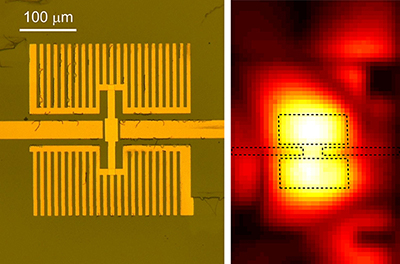
Graphene’s benefits are opening possibilities in high-performance infrared (IR) imaging and spectroscopy. Researchers from the Graphene Flagship (the EU’s biggest ever research initiative), working at the University of Cambridge (UK), Emberion Ltd (UK), the Institute of Photonic Sciences (ICFO, Spain), Nokia UK and the University of Ioannina (Greece) have developed a graphene-based pyroelectric bolometer that detects infrared (IR) radiation by measuring tiny temperature changes with an ultra-high level of accuracy. The work, published in Nature Communications, demonstrates the highest reported temperature sensitivity for graphene-based uncooled thermal detectors, capable of resolving temperature changes down to a few tens of µK. Only a few nano-Watts of IR radiation power are required to produce such a small temperature variation in isolated devices, about 1000 times smaller than the IR power delivered to the detector by a human hand in close proximity.
The high sensitivity of the detector is of great use for spectroscopic applications beyond thermal imaging. With a high-performance graphene-based IR detector that gives a strong signal with less incident radiation, it is possible to isolate different parts of the IR spectrum. This is of key importance in security applications, where different materials—such as explosives—can be distinguished by their characteristic IR absorption or transmission spectra.
Dr Alan Colli, Principal Engineer at Emberion and co-leader of the research, said: “With a higher sensitivity detector, one can restrict the large thermal band and still form an image using photons in a very narrow spectral range and do multi-spectral IR imaging. For security screening, there are specific signatures that materials emit or absorb in narrow bands. So, you want a detector that is trained in that narrow band. This can be useful while looking for explosives, hazardous substances, or anything of the sort.”
Typical IR photodetectors operate either via the pyroelectric effect, or as bolometers, which measure changes in resistance due to heating. The graphene-based pyroelectric bolometer combines both approaches with the excellent electrical properties of graphene, for maximum performance. Graphene acts as a built-in amplifier for the signal, removing the need for external transistors—meaning no losses from parasitic capacitance and remarkably low noise. The high conductivity of graphene also offers a convenient impedance matching with the external readout integrated circuit (ROIC) used to interface with the detector pixels and the recording device. With the continuous improvement in the quality of graphene (e.g., higher mobility), robust devices with an extended dynamic range (temperature range over which the device will operate reliably) can be fabricated while maintaining the same excellent temperature responsivity.










